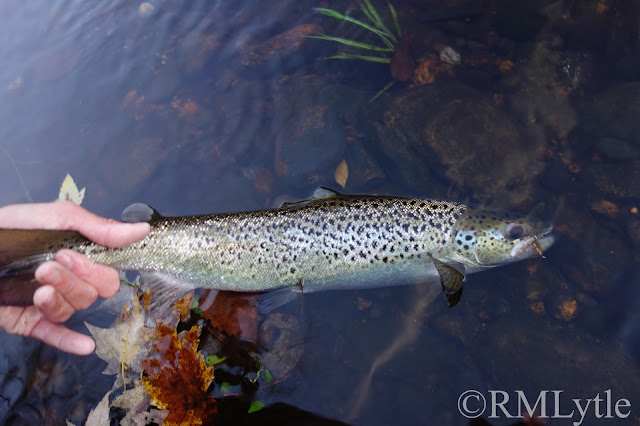The early season for CT broodstock Atlantic salmon the last few years has come with very low warm water. These conditions are less than enjoyable and prevent me from fishing for these salmon the way I really want to: traditional flies, swinging, spey casting. Though this isn't a real salmon fishery, I like to fish it like it is. About the only upside of the early season low water and warmth is the opportunity to get the fish to take a dry fly or riffle hitched wet, witch of course still falls in the bounds of classic Atlantic salmon tactics and is also very exciting. This year I was finally able to actually put time into this fishery and go at it on my own, and I badly wanted to get one on a dry. That said I also wanted to catch fish. So when I moved a small salmon twice with a Bomber, then couldn't get it to rise again even after a ten minute rest, I did what I knew would work and two hand retrieved a tiny Mickey Finn over it and the fish quickly obliged.
 |
| Pinkie out for Salmo salar |
The fish was small but a firecracker. It spent a lot of time in the air and tried to make some runs, though it wasn't even close to heavy enough that I couldn't turn it without any fear of my 8lb tippet failing. The take was the highlight, I love when an Atlantic wakes up on a fly that on or just under the surface, and it always feels nice to come tight when two hand retrieving saltwater style. This is an underutilized method on freshwater rivers. I'd picked it's use up for broodstock salmon from my friend and experienced salmon fisherman Ben Bilello (actually my use of basically every tactic in the post should be credited to Ben) some year back and have applied it effectively on both salmon and trout since. Sometimes keeping the fly moving more or less continuously is very important. In this sort of fishing, down and across swinging for fish willing to move for the fly, it means the angler isn't relying on the pace of the current to set the speed of the swing. I can get the fly swinging fast in water it would otherwise be moving uncomfortably sluggish.
The next run down yielded no moved fish to a hitched wet, so I made another pass at it with the same little Mickey Finn. I sent another small salmon airborne there that didn't stay pinned. Later on, I moved another with the bomber before it went silent until, again, a two handed Mickey got it up and stuck. Once more it was a fantastic fighter though not at all a big fish.
 |
| Always pinkie out. |
My confidence with fine wire hook size 10-14 Mickey Finns for early season broodstock salmon is three fold. First off, red and yellow can do no wrong with these fish for the first month and a half of the short season. Second, small fine hooks are much easier to bury in a fish's mouth. Third, once they're in the fish they're more inclined to stay there. Perhaps some of this confidence originates in the first adult salmon I caught, my only true sea-run Atlantic, which was taken on a size 14 Sedgehammer. In low water the salmon are more inclined to notice and strike such a small fly, so it is a good move to take advantage of this and set your presentation apart from the crowd of big flies, spoons, and spinners these fish are being bombarded with as well as something more likely to get a good solid hookup.


Great write up of catching the Atlantic salmon. I think I hooked a land locked in the Swift that came over the dam during high flow last year. Never brought to net, it spent as much time in the air as in the water. What a blast!
ReplyDeleteThanks!
DeleteYeah there were a couple of years there where a lot of big landlocked salmon spilled over that dam.